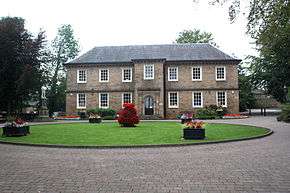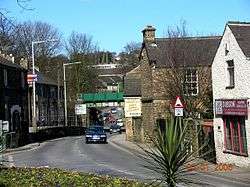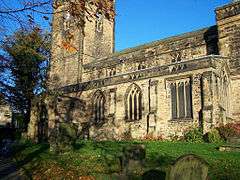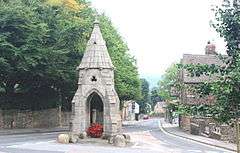Dronfield
| Dronfield | |
 Dronfield Library |
|
 Dronfield |
|
| Population | 21,330 |
|---|---|
| OS grid reference | SK355785 |
| District | North East Derbyshire |
| Shire county | Derbyshire |
| Region | East Midlands |
| Country | England |
| Sovereign state | United Kingdom |
| Post town | DRONFIELD |
| Postcode district | S18 |
| Dialling code | 01246 |
| Police | Derbyshire |
| Fire | Derbyshire |
| Ambulance | East Midlands |
| EU Parliament | East Midlands |
| UK Parliament | North East Derbyshire |
|
|
Coordinates: 53°18′09″N 1°27′59″W / 53.3024°N 1.4664°W

Dronfield is a town in North East Derbyshire in the North Midlands region of England. It comprises the three communities of Dronfield, Dronfield Woodhouse and Coal Aston. It is sited in the valley of the small River Drone, and lies between the town of Chesterfield and the city of Sheffield. The Peak District National Park lies 3 miles to the west. The town's name means open land infested with drones (male bees).
The town is known to have been in existence prior to the 1086 Domesday Book, and has a 12th-century parish church. In 1662 Charles II granted the town a market, although this later ceased. The industrial history of the town includes coal mining, the wool trade, the production of soap and steel, and engineering. Today a range of manufacturing firms still operate within the town.
Dronfield's population has increased dramatically in post-war years from 6,500 in 1945 to its current size of just over 21,000.[1]
The football ground to the north of the town is currently the home of Sheffield F.C., the world's oldest football team.
History
Dronfield is a market town, but little is known about its early history. It is known to have been in existence before the 1086 Domesday Book and suffered after the Norman conquest when William the Conqueror sought to bring the North of England under control. Its name derives from the Old English drān and feld, meaning open land infested with drones (male bees).[2]
The Church of St John the Baptist is known to have been built by 1135 when Oscot was rector with the parish of Dronfield covering Little Barlow, Coal Aston, Povey, Holmesfield, Apperknowle, Dore and Totley. Its churchyard contains the stump of a preaching cross which may be Anglo-Saxon; if so, it would pre-date the main church.
The Guild of the Blessed Virgin Mary was established in 1349 in the hall of the chantry priests. However, due to the Dissolution of the Monasteries and the subsequent suppression of the guilds and chantries in 1547, it became a local inn which still operates today as the Green Dragon Inn.
Between the 16th and 19th centuries, Dronfield grew around various industries, the most widespread of which was coal mining, with pits at Stubley being mentioned in the 16th century and a map of Hill Top in the 17th century showing some workings. Further mines were opened at Coal Aston in 1785 and Carr Lane in Dronfield Woodhouse in 1795.
The town also benefited from trade with the lead mining and grindstone industries in the Peak District. The wealth of the Rotheram family, who became the Lords of the Manor of Dronfield, was based on the lead trade. Notable buildings in the town include several 16th- and 17th-century houses.
During the 16th century, Dronfield with its sheep farmers had a significant number of families working in the wool trade, engaged in spinning and weaving and also the production and selling of cloth. Soaper Lane, being next to the river, was the centre of the soap-making and tanning industry in the town, with a dye works also situated there.
In 1662 Dronfield was granted a market by Charles II, but in the 18th century, due to the nearness of Sheffield and Chesterfield, the market went into decline and ceased to exist.
In 1882 William Cammell's steelworks, which specialised in rolling rails, was 'removed' to Workington in west Cumbria.[3] Steelworkers and their families moved too. It is estimated that 1,500 townspeople made the trip to Workington. 'Dronnies', as the people of Workington called the newcomers, formed Workington AFC in 1888.[4]
In 1993 Dronfield Henry Fanshawe School (formerly the 'Dronfield School' and previously 'Dronfield Grammar School') suffered major damage when its 1960s system-built blocks were completely gutted by fire, requiring all firefighting resources from all nearby towns and Sheffield to control the blaze. The historic Victorian quadrangle and library, as well as the sixth-form block, survived. The remains of the modern school were subsequently demolished and mobile cabins were used as classrooms until 1996 when the school was rebuilt.
Geography
Dronfield is sited in the valley of the River Drone in North East Derbyshire, England. It lies roughly midway between the town of Chesterfield to the south and the city of Sheffield to the north, for which it is a popular commuter town.
The A61 trunk road Dronfield–Unstone Bypass cuts through the town, although this is not directly accessible from the town centre itself. Instead a network of secondary roads serves local traffic: the B6054, B6056, B6057 and B6158. Dronfield is also served via rail through Dronfield railway station.
Dronfield covers an area of 3,457 acres (13.99 km2) and has as neighbours the villages and hamlets of Unstone, Holmesfield, Barlow, Apperknowle, Hundall, Marsh Lane and Eckington.
Situated close to the Pennines and many of the beauty spots of Derbyshire, Dronfield also has easy access to the Peak District National Park just 3 miles (4.8 km) away.
Economy
The town has a range of businesses, mainly located on the Callywhite Lane Industrial Estate at the eastern end of the town off the main Sheffield to Chesterfield road. The main businesses in the town were originally associated with engineering trades, but over recent years have diversified. The principal business is the William Lees Iron Foundry, which dates back to the 1800s and was responsible for major growth in the town at that time. The foundry mainly supplies malleable iron castings to the automotive industry.
Major companies with works in Dronfield include:
- Henry Boot PLC – Builders, area offices
- Banner Plant – Plant Hire Yard & HQ, a division of Henry Boot Plc.
- Padley & Venables Ltd – Manufacturers of rock cutting tools and bits.
- Peak Quantum Ltd - providing quantum expert witness services to the construction and engineering industries.
- Hodkin & Jones – Decorative plaster mouldings HQ & factory.
- Land Instruments International – Manufacturers of infra-red temperature measurement and combustion efficiency and environmental monitoring equipment. Land was taken over in 2006 by AMETEK Inc.
- Gunstones Bakery (Northern Foods) – Suppliers of baked products to M&S, etc. The firm was founded in Sheffield in 1862, moving to Dronfield in 1950, and taken over by Northern Foods in 1970.
The Sheffield firm of Ponsford's Furniture have opened their new distribution warehouse in the town. Various smaller companies occupy units on the estate. Some modern high-tech businesses have premises in the town, such as EFI (formerly RADIUS) a packaging software systems supplier.
Demography
Dronfield's population has increased dramatically in post-war years from 6,500 in 1945 to its current size of just over 21,000. This mainly reflects its position as a dormitory community for workers from nearby Chesterfield and Sheffield (which has in the past attempted to bring the town within its own boundaries). Today the town comprises the previously separate but now physically contiguous communities of Coal Aston, Dronfield, and Dronfield Woodhouse.
Dronfield Woodhouse once claimed to have the largest privately owned housing estate in Europe ("Gosforth Valley") when it was first built in the 1970s. During the same decade, on 16 October 1975, the £6.5m 5-mile (8.0 km) A61 Dronfield–Unstone Bypass was opened running through the western side of the town, to allow easier access for travel between the larger populated areas of Sheffield to the north and Chesterfield to the south.

Sport and leisure
The town's football ground, located next to the Coach and Horses pub, is now home to the world's oldest football team, Sheffield F.C..
There is a rugby league side that goes by the name of Dronfield Drifters RLFC.
The leisure centre is next to the civic centre.[5]
The cricket pitch on Stonelow Road is the home of the local Coal Aston Cricket Club. The ground has high-quality facilities including home and away changing rooms, a tea room, an electronic scoreboard, a seating area in front of the pavilion and an astro-turf practice net.
Notable events are the annual Dronfield Gala and the Dronfield Woodhouse and Coal Aston Well Dressings which are held in July.
The Dronfield 2000 Rotary Walk is a 14.5-mile (23.3 km) circular walk that circumnavigates the town.[6]
Media
Dronfield is served by a monthly magazine (The Dronfield Eye), and formerly by a weekly local newspaper (the Dronfield Advertiser). The Dronfield Eye also publishes the annual Dronfield Directory, which lists details of hundreds of local groups, societies and organisations.
Dronfieldonline is a locally run website, providing information online for the Dronfield community. It contains information about the area, including schools, property, local news, events provided by and for the people of Dronfield, and links to local clubs and associations. The site also has a full business directory and fully supports local business and enterprise.
Dronfield Digital, a youth-focused online publication which emerged in late 2012, provides opinion pieces, fake news and satire of small-town life in Dronfield.

Landmarks and facilities
Despite its recent growth, Dronfield's centre has managed to keep its ancient character with a number of historic buildings still intact. These include Dronfield Manor which is now the town's library, Dronfield Henry Fanshawe School which was established in 1579 through a bequest in the will of Henry Fanshawe (which was implemented by his nephew Thomas Fanshawe), and a 15th-century building with a king post roof, long used as a barn. The 12th-century parish church exhibits a fine 138-foot (42 m) spire.
Town-centre shoppers are well served by car parking facilities, the main shops, civic amenities and sports centre with swimming pool lying conveniently in the upper town around the civic centre.
St. John the Baptist Parish Church

Built in the 12th century, the parish church of St. John the Baptist is built following the style of early Gothic architecture and features a number of stained glass windows. Its spire can be seen from most of Dronfield. It has its own choir and its own music group run by young members of the church.
St John the Baptist has two misericords, both 20th-century additions (one of the stalls bears the inscription “To the glory of God and in memory of Nellie Gertrude Lucas of Red House, Dronfield, these clergy desks were given by her husband, Easter 1923”):
- Angel in attitude of prayer
- Angel with arms folded across breasts
Peel Monument

The "Peel Monument", situated on the town's High Street, was built in 1854 out of gritstone as a tribute to Sir Robert Peel, to commemorate his repeal of the Corn Laws in 1846. The monument is very distinctive, and is often portrayed in images of the town. For instance, it is the main device featured on the badge of Dronfield FC.
The Cottage
Near to the Peel Monument on High Street is a 16th-century house known as 'The Cottage'. It is believed that it was once owned by Lord Byron (1788–1824), though there is no proof that he was a Dronfield resident.
Cliffe Park
Located off Callywhite Lane, Cliffe Park has a number of amenities for local residents including a children's adventure play area, tennis courts and a bowling green.
River Drone
The River Drone is a small river that runs through Dronfield. It then joins the Barlow Brook at Unstone, and then flows into the River Rother at Whittington Moor, Chesterfield.
Gosforth Fields Sports Complex
In January 2010, a new £2.5 million sports complex opened on the old Gosforth School site. Run by three local teams, AFC Dronfield, Dronfield Town & Dronfield RFU, the complex includes a state-of-the-art 3G pitch, 10 full-size pitches, changing facilities and a social area. It was officially opened by Sir Trevor Brooking and John Owen.[7]
Gosforth Fields is the home of Dronfield Rugby Club.[8]
Other facilities
-

The Blue Stoops pub
-

The Greyhound pub
-

The White Swan pub
Dronfield has many pubs, including: the Blue Stoops, the Bridge, the Coach & Horses, the Green Dragon, the Three Tuns (formerly the Hallowes and before that the Masons Arms), the Hearty Oak, the Hyde Park, the Jolly Farmer (formerly the Gorsey Brigg), the Miners Arms, the Dronfield Arms (formerly the Sidings and before that the Midland), the Talbot Arms, the Victoria, the White Swan, the Cross Daggers, the Yew Tree and the Chequers.
Dronfield also has several social clubs: The Contact Club, Dronfield Woodhouse Sports & Social Club, Hill Top Sports & Social Club and the Pioneer Club.
Dronfield is home to 1890 (Dronfield) ATC Squadron.
Twinning
-
 Sindelfingen, Germany – home of Mercedes-Benz.
Sindelfingen, Germany – home of Mercedes-Benz.
A park in Dronfield Woodhouse was renamed after Sindelfingen in the early 1990s to celebrate this partnership (established in 1972).
Dronfield Henry Fanshawe School has an annual student exchange with a school in Sindelfingen; this exchange helps establish links between the young people in the two towns.
Education
- Dronfield Henry Fanshawe School on Green Lane takes its intake from all of the 8 schools within Dronfield and the surrounding area, occasionally also including pupils from Sheffield and the Chesterfield area.
- Dronfield Junior School is the biggest primary school in Dronfield, reaching over 300 students.
- William Levick Primary School had a school roll of 209 pupils as of 2009.[9]
Notable people
A number of notable people were either born or have lived in Dronfield, these include:
- Rick Allen, drummer with rock group Def Leppard, was born in the town.[10]
- Dave Berry, musician, lives in the town.[11][12]
- Gary Cahill, footballer for Chelsea and England, grew up in the town and attended Dronfield Henry Fanshawe School.[13]
- Bruce Chatwin, novelist and travel writer, was christened in the parish church and briefly lived in the town during the first weeks of his life.[14]
- Tony Currie, ex-Sheffield United, Leeds United and England footballer.
- Kevin Gage, ex-Sheffield United, Wimbledon and Aston Villa footballer – now landlord of the Green Dragon pub on High Street
- Roy Goodall, former England football captain
- Howard Kendall, ex-Sheffield United and Everton manager
- Kevin Pressman, ex-Sheffield Wednesday goalkeeper, attended Dronfield Henry Fanshawe School
- Mark Roe, former European Tour Golfer and Sky Sports Golf analyst
- Peter Springett, played in goal for Queens Park Rangers and later Sheffield Wednesday, Barnsley and Scarborough
- Mel Sterland, ex-Sheffield Wednesday, Leeds United and Glasgow Rangers footballer
- Paul Tomlinson, ex-Sheffield United and Bradford City footballer, former Landlord of the Greend Dragon and Hyde Park Inn.
References
- ↑ "Area: Dronfield (Parish), Key Figures for 2011 Census". Neighbourhood Statistics. Office for National Statistics. Retrieved 24 March 2016.
- ↑ David Mills (ed.). A Dictionary of British Place Names. Oxford University Press. p. 160. ISBN 978-0-19-960908-6.
- ↑ Byers Richard (2003), The History of Workington, An Illustrated History from 1866 to 1955, Richard Byers Pub. Cockermouth. p108 and 109
- ↑ Byers Richard (2003), The History of Workington, An Illustrated History from 1866 to 1955, Richard Byers Pub. Cockermouth. p109
- ↑ http://www.ne-derbyshire.gov.uk/leisure--culture/leisure/dronfield
- ↑ http://www.thewalk.org.uk
- ↑ "Sir Trevor Launches Dronfield's new £2.4M sports complex". The Star. 15 January 2010. Retrieved 28 March 2016.
- ↑ Kent, Gareth (9 September 2012). "Dronfield Rugby Club". Pitchero.com.
- ↑ Willam Levick Primary School info, Ofsted
- ↑ "Def Leppard". www.britannica.com. Encyclopaedia Britannica Inc. Retrieved 24 February 2016.
- ↑ "DRONFIELD: Birthday boy Dave Berry kicks off tour at Sheffield City Hall". derbyshiretimes.co.uk. Derbyshire Times. 6 February 2013. Retrieved 24 February 2016.
- ↑ "Three of the most successful act's of the 60s". "Crying Game" - the official Dave Berry website. 21 January 2011. Retrieved 24 February 2016.
- ↑ "Cahill: a local lad done very well". derbyshiretimes.co.uk. Derbyshire Times. 23 January 2012. Retrieved 24 February 2016.
- ↑ Shakespeare, Nicholas (2000). Bruce Chatwin. Random House. p. 23. ISBN 9780099289975.
External links
| Wikimedia Commons has media related to Dronfield. |
 "Dronfield". Encyclopædia Britannica. 8 (11th ed.). 1911.
"Dronfield". Encyclopædia Britannica. 8 (11th ed.). 1911.- Dronfield Town Council
- Dronfield in the Domesday Book
- Short synopsis of Dronfield
- Dronfield Rotary Club
- The Peel Centre
- St John the Baptist Church, Dronfield
- Dronfield Digital
- Dronfield directory
- The Dronfield Round Walk
- Dronfield Civic Society